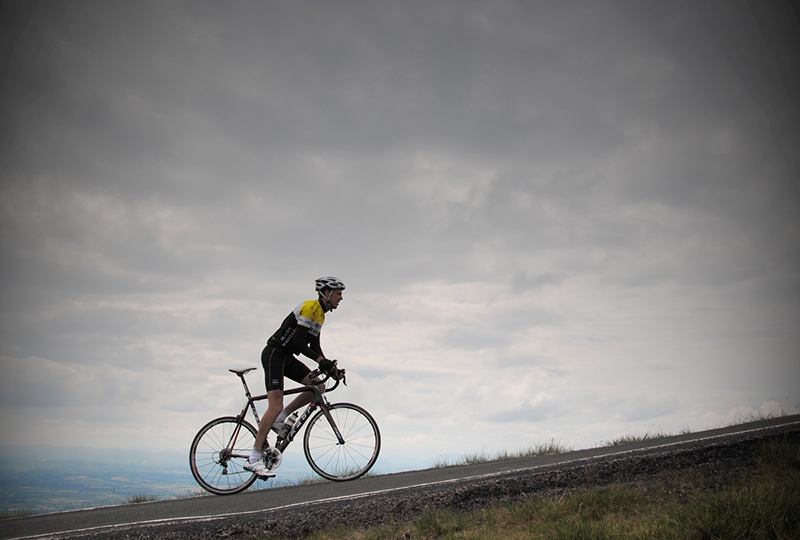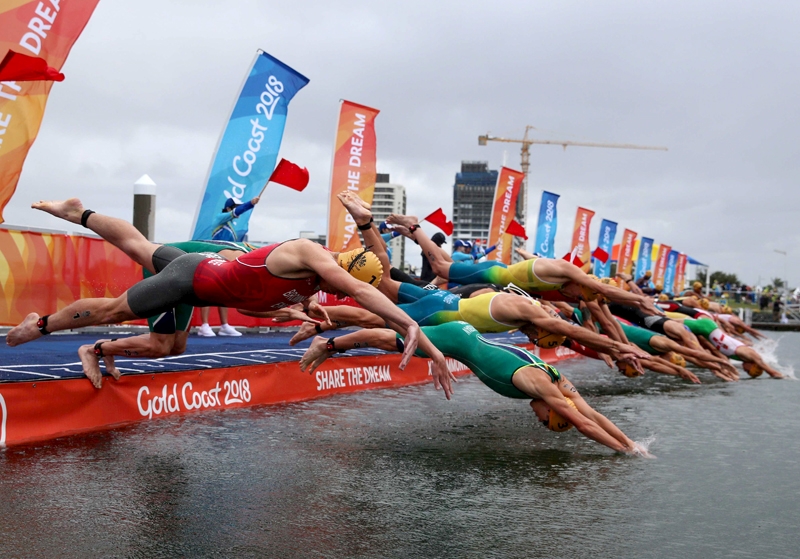You are viewing 1 of your 1 free articles. For unlimited access take a risk-free trial
Polarized training: does it really work for recreational athletes?

Evidence for a polarized approach to training intensity distribution in elite athletes has steadily mounted in recent years. However, some new research suggests that in amateur and recreational athletes, a more conventional pyramidal approach could actually produce better performances in a race situation. Andrew Hamilton explains
For recreational and non-elite athletes preparing for an event such as a marathon, triathlon or sportive, two of the most commonly asked questions are ‘how much training should I be doing’ and ‘how hard should I be training’? Of course, the answers to these depend on a number of factors, including your previous training experience, your current fitness level, and the distance of the event. For novice athletes tackling a long event for the first time, the biggest priority will be to ensure that the training volume performed in the run up to the race is sufficient to get them to the end in decent shape (a good time is merely a bonus). So here, the emphasis should be firmly on ensuring adequate training volume rather than intensity. However, those who are familiar with and confident of completing an event will want to consider improving their times – and that’s where training intensity and how to structure it comes in.The Goldilocks approach
Recreational and amateur athletes who have a good level of base fitness under their belts are often tempted to use a middle of the road or ‘Goldilocks’ approach. This approach is one where the athlete spends a significant amount of time training at a moderate-hard intensity - hard enough to push the body out of its comfort zone and promote gains in swimming/cycling/running endurance, but not so hard as he/she ends up exhausted. Using this approach will almost always ensure further gains in fitness and performance are made compared to a diet of only long, slow distance training – up to a point at least. However, while this may seem intuitively correct, in recent years, a growing body of evidence has accumulated that for maximum performance gains, there could be a better way. This better way revolves around a concept known as ‘polarized training’.The polarized approach to training says that moderate-hard intensity training – ie near to your lactate threshold - is rather unproductive for making fitness gains. Instead, it proposes that endurance athletes such as triathletes, runners and cyclists would be better to spend a large proportion of their training time working at low intensity (ie in the ‘easy’ purely aerobic zone – zone 1) and a small proportion at a very high intensity (near maximum power output – zone 3) with very little time spent training at or near to lactate threshold (zone 2 - see table 1).
The thinking is that polarized training provides an excellent ‘aerobic foundation’ yet allows for high-intensity work that really stimulates training adaptation (ie aerobic fitness gains) without becoming too tired. The conventional ‘middle of the road’ approach on the other may be flawed; it could mean that you spend much of your time training hard enough to tire you out and never leave you feeling really fresh, but never hard enough to provide the training stimulus your muscle fibers need to make maximum fitness gains.
Table 1: The structure of a polarized training intensity distribution

The polarized theory of training uses the concept of ‘intensity zones’. Basically, this concept assigns your time spent training into three zones - 1, 2 and 3 - which refer to easy, moderately hard and extremely hard intensities of training respectively (see below). Studies on elite athletes such as runners and rowers suggest that the best way of achieving your maximum endurance potential is to spend the bulk of your training time in zone 1, ensure you spend at least some time in zone 3 but not to spend too much time in zone 2 (the moderately hard zone).
Follow the elites
The early evidence for the benefits of polarized training tended to be rather anecdotal; sports scientists noticed that many of the very best-performing endurance athletes seemed to perform the bulk of their training at an easy intensity but with combined with some extremely high-intensity work too. By contrast, moderate-hard lactate threshold training didn’t seem to feature much in most elites’ programmes.In more recent years however, studies have revealed that the ubiquitous use of a polarized approach is among elites is no coincidence, because it really does seem to offer performance benefits. For example, one study looked at cyclists who completed two blocks of 6-week endurance training periods with similar total training volumes but with differing intensity distributions(1):
- Polarized, averaging 6.4 hours per week spending 80%, 0% and 20% of training time in low, moderate and high intensity zones respectively;
- A much more middle of the road (threshold training) block, averaging 7.5 hours per week spending 57%, 43% and 0% of training time in low, moderate and high intensity zones respectively.
These results also tied in neatly with those from a comprehensive study on triathletes, cyclists, runners and cross-country skiers(4). This study compared four training approaches over a 9-week period (high-volume training, lactate threshold-training, high-intensity interval training and polarized training) to see which produced the greatest gains in key components of endurance performance. The results showed that while the high-intensity intervals produced good gains, it was the polarized training that resulted in the greatest improvements (see figure 1a and 1b). Interestingly, both the lactate threshold and high volume (mainly low-intensity work with very little high-intensity training) approaches failed to produce any further improvement in endurance – noteworthy because this is how many endurance athletes actually train!
Figures 1a and 1b: Endurance performance gains after four different training modes


NB: maximum speed at lactate threshold is a good determinant of race performance.
Is polarized always best?
The evidence from these (and other) studies on elite athletes has led sports scientists to conclude that when maximum performance is desired, a polarized training approach is best. This in turn has led many amateur and recreational athletes to completely rethink their training structure, cutting back on moderate-hard intensity workouts and adopting a more polarized approach instead. The problem however is that the training backgrounds and volumes undertaken by amateur and recreational athletes are very different to elite athletes -and nobody stopped to ask - let alone test - whether this kind of training structure is equally appropriate for non-elite athletes. But now some new research has tried to answer exactly this question, and it looks like a one-size fits all training prescription may not be such a good idea after all…In a newly published study by Spanish scientists, researchers have compared performances of triathletes competing in a Half-Ironman triathlon(5). In particular, they sought to try and relate the training intensity distributions with performance during a Half-Ironman race in two groups of triathletes that followed two different training intensity distributions:
- Polarized - 84.4%4.3%/11.2% distribution of total training time for zones 1,2 and 3, respectively (typical profile of intensity distribution recommended for elite endurance athletes)
- Pyramidal - 77.9%/18.8%/3.3% distribution of total training time for zones 1,2 and 3, respectively (the typical kind of intensity distribution followed by non-elite endurance athletes when left to their own devices)
At the end of this 7-week period, fitness testing was undertaken and the triathletes were then split into two groups, each following one of the two above training intensity distributions (polarized or pyramidal) for a period of 12 weeks. Importantly, the total training volume prescribed was identical for both groups (155 training hours over the 12-week period), and all the triathletes followed the same periodisation protocols, performing increased training loads and decreased training loads at the same time points over the 12-week period. In addition, the nutrition and hydration needs of the athletes were controlled across both groups to ensure a level playing field. Both groups also spent the same amount of time practicing transitions and swimming skills. In fact, the only real difference between the groups was their training intensity distributions over the 12 weeks, which are shown in figure 2.
Figure 2: Time percentage in each zone by segment during specific training period

NB: <VT1 = zone 1; VT1-VT2 = zone 2; >VT2 = zone 3
The findings
At the end of the 12 weeks, the triathletes underwent further testing to see how much their fitness levels had improved. A week later, they competed in the Half-Ironman race, where performance was also closely monitored. The results surprised the researchers. These were as follows:- No significant differences were observed between the polarized and pyramidal race times. In fact, only two seconds differentiated both groups in the race that lasted over five hours!
- Both training distributions showed produced significant fitness gains in the triathletes – in all three disciplines.
- The pyramidal group showed a statistically significant improvement in maximum running speed at VT2 (lactate threshold) and the maximum aerobic speed (maximum sustainable speed before lactate accumulation begins). However, the polarized group did NOT experience these gains – gains that led the pyramidal group to turn in slighter faster times in the Half-Ironman race.
- Surprisingly, the pyramidal group triathletes who spent more time working in zone 3 (>VT2) had worse times in the running segment and in their Half-Ironman times overall!
What does this mean for recreational athletes?
Nearly all of the previous research on polarized training has focussed on elite athletes. This however is the first study to manipulate training intensity distribution in recreational triathletes and to observe the effects on race performance. What this research shows is that for non-elite athletes, adhering to a polarized distribution of training intensity may not be necessary (unlike elite athletes). In fact, it might even result in slightly poorer performance. In terms of training prescription then, it is likely that many recreational athletes may not need to adopt a polarized approach to maximise performance – although including some zone-3 sessions is still likely to produce benefits.Why might there be differences in the training responses of elite and non-elite athletes to a polarized intensity distribution? At this point, we can only speculate. One reason might be that since elite athletes are already highly aerobically trained (with superb lactate threshold abilities), further gains can only really be achieved by spending more time in zone 3. But for less fit non-elite athlete, good gains can still be made in zone 2. Another reason is that elite/professional athletes perform much higher training volumes than non-elite athletes. Very high volumes of zone-1 training may be particularly useful in honing fat-burning and muscle efficiency, which allows them to conserve more glycogen for later in the race. Non-elite athletes on the other hand simply don’t have the time or the training background to perform such a high volume of zone-1 training (although it’s still the core of any endurance program). Once again, they may be able to derive greater gains from a bit more zone-2 training.
In summary then, what this research suggests is that although the ‘polarized is best’ mantra might be correct for elite athletes, the same is not necessarily true for recreational/amateur athletes. More research will be needed to confirm these findings, but in the meantime, if unless you’re an elite athlete, there seems little to gain by switching to a polarized approach. This still means that 70-80% of your training volume should be conducted in zone 1, but that you shouldn’t eschew zone-2 sessions working at or near lactate threshold, because these might the very sessions that generate the biggest gains in performance!
References
- J Appl Physiol. 2012 Dec 20.
- Int J Sports Physiol Perform. 2014 Jan;9(1):93-9
- Int J Sports Physiol Perform. 2012 Jun;7(2):103-12
- Front Physiol. 2014 Feb 4;5:33. doi: 10.3389/fphys.2014.000335
- Journal of Sports Science and Medicine (2019) 18, 708-715
Newsletter Sign Up
Testimonials
Dr. Alexandra Fandetti-Robin, Back & Body Chiropractic
Elspeth Cowell MSCh DpodM SRCh HCPC reg
William Hunter, Nuffield Health
Newsletter Sign Up
Coaches Testimonials
Dr. Alexandra Fandetti-Robin, Back & Body Chiropractic
Elspeth Cowell MSCh DpodM SRCh HCPC reg
William Hunter, Nuffield Health
Keep up with latest sports science research and apply it to maximize performance
Today you have the chance to join a group of athletes, and sports coaches/trainers who all have something special in common...
They use the latest research to improve performance for themselves and their clients - both athletes and sports teams - with help from global specialists in the fields of sports science, sports medicine and sports psychology.
They do this by reading Sports Performance Bulletin, an easy-to-digest but serious-minded journal dedicated to high performance sports. SPB offers a wealth of information and insight into the latest research, in an easily-accessible and understood format, along with a wealth of practical recommendations.
*includes 3 coaching manuals
Get Inspired
All the latest techniques and approaches
Sports Performance Bulletin helps dedicated endurance athletes improve their performance. Sense-checking the latest sports science research, and sourcing evidence and case studies to support findings, Sports Performance Bulletin turns proven insights into easily digestible practical advice. Supporting athletes, coaches and professionals who wish to ensure their guidance and programmes are kept right up to date and based on credible science.













